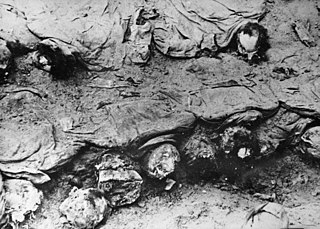共產主義政權下的大屠殺
共产主义者有组织地大量杀害非战斗人员的情景 来自维基百科,自由的百科全书
20世紀發生在共產主義政權下的大規模屠殺被估計造成了總計8500萬到1億人之間的非正常死亡。[1]學術研究集中在造成單一的社會下的大規模屠殺的原因,雖然一些造成大屠殺的常見原因已經發表出來。一些對大屠殺更高的估計不僅包括了發生在大規模的謀殺或者清除政治對手、內戰、恐怖活動和土地改革期間的處決,還包括了因為戰爭、饑荒、疾病和過勞而在勞改營喪失性命。這些研究者相信政府的決策和管理的失誤導致了這些災難,而且,基於那一結論將該些死亡一併歸類於「大屠殺」、民眾滅絕、政治滅絕、階級滅絕或者寬鬆定義的種族滅絕。根據這些研究,以此定義的大規模屠殺的死亡總數數以千萬計;然而,該方法的有效性受到了其他學者的質疑。截至2011年[update],學術界對於這些國家發動大規模屠殺的原因還沒有達成共識,包括共產黨領導下的政權。尤其是,探討當中原因的比較性研究數目有限。死亡人數最多的時期包括約瑟夫·斯大林領導下的蘇聯、毛澤東領導下的中華人民共和國和紅色高棉領導下的柬埔寨。這三個國家的非戰鬥人員被殺戮的數目單獨估計在2100萬到7000萬之間。[2][可疑]規模較小的則是出現在朝鮮民主主義人民共和國、越南,以及一些東歐和非洲國家。
術語
共產主義政權——「共產主義政權」表示那些在歷史上的一段時期裡面自稱以馬列主義、斯大林主義或毛澤東思想為指導的國家(也叫「共產主義國家」)。
學者們用一些不同的術語來描述對非戰鬥人員的蓄意屠殺。[3][4]下列術語被用來描述共產主義政府所造成的屠殺:
- 種族滅絕——在防止及懲治滅絕種族罪公約中,種族滅絕罪不包含對政治或社會群體的大屠殺。對政治群體的保護在第二輪投票後從聯合國決議中撤回,因為許多國家,包括當時由斯大林領導的蘇聯,[5]事前考慮到該章節會對他們鎮壓內部動亂的權利作出不必要的限制。[6]
- 政治滅絕——術語「政治滅絕」用來描述不會被《防止及懲治滅絕種族罪公約》所規範,針對政治或經濟群體的殺戮。[7]Manus I. Midlarsky用術語「政治滅絕」來描述由蘇聯西部地區直至中國和柬埔寨的大規模屠殺。[8]在他的書《The killing trap: genocide in the twentieth century》裡面對斯大林和波爾布特的屠殺提出了相似點。[9]
- 民眾滅絕——魯道夫·拉梅爾創造了術語「democide」,其中包含種族滅絕、政治滅絕和屠殺。[10]海倫·費因把發生在蘇聯和柬埔寨的國家造成的大屠殺稱作「種族和政治滅絕」。[11]Frank Wayman和Atsushi Tago展示出術語的意義在於,若以民眾滅絕(廣泛的國家製造的屠殺)或政治滅絕(受到政府反對的少數群體)的使用作為包含於數據集的條件,尋求大屠殺之間聯繫的統計分析能造成非常不同的結果,包括政權類型的意義或其他方面。[頁碼請求][12]
- 危害人類罪——雅克·森密林和邁克爾·曼[13]相信「危害人類罪」在談論共產主義政權的暴力行為的時候比「種族滅絕」或者「政治滅絕」更確切。[14]
- 階級滅絕——邁克爾·曼提出了術語「階級滅絕」以表示「旨在對整個社會階級的大屠殺」的意思。[15]
- 恐怖——史蒂芬·惠特克羅夫特指出,在蘇聯,像「恐怖」「清洗」「鎮壓」這樣的術語(後者一般是俄語)一般指的是同樣的事件,而且他相信更為中立的術語是「鎮壓」或「大屠殺」。[4]
- 大屠殺——這個術語被本傑明·瓦倫蒂諾定義為「對大量非戰鬥人員蓄意的殺戮」,其中「大量」被定義為五年或更短時間內造成至少50,000人惡意地死亡。[16]他把這一定義應用在了斯大林領導下的蘇聯、毛澤東領導下的中國和紅色高棉領導下的柬埔寨,同時承認人數較少的大屠殺也出現在朝鮮民主主義人民共和國、越南、東歐和非洲。[17]

提出的原因
一些理論,比如魯道夫·拉梅爾的,提出共產主義是大屠殺的明顯的誘發因素,引起了學術爭議;[23]此條目不討論該些理論的學術認可。
克拉斯-戈蘭·卡爾松寫道「意識形態是思想的系統,本身不能犯罪。然而,把自己定為共產主義者的個人、集體和國家,在共產主義的意識形態的名義下犯罪,或者在談論他們犯罪的動機的直接來源時不提及共產主義。」[24]
根據魯道夫·拉梅爾,共產主義政權所做的屠殺可以解釋為絕對權力和絕對意識形態——馬克思主義的結合。[25]
「在所有的信仰當中,不論是世俗的或其他的」,拉梅爾把馬克思主義定位為「迄今為止最血腥的——比宗教裁判所、歷次天主教十字軍東征和天主教和新教之間的三十年戰爭還要血腥。事實上,馬克思主義意味着血腥的恐怖主義、極端的清洗、致命的集中營與致死的強制勞動、毀滅性的放逐、人為的饑荒、法外處決與欺詐性的作秀審判、徹底的大規模謀殺與種族滅絕。」[26]他寫道事實上馬克思主義者把他們構造烏托邦的過程視為「對貧窮、剝削、帝國主義和不平等的戰爭——而且,就像一場真正的戰爭,非戰鬥人員會不幸地捲入戰鬥中。會有必要的敵人傷亡:神職人員、資產階級、資本家、『肇事者』、知識分子、反革命分子、右派分子、暴君、財主和地主。就像一場戰爭中,數以百萬計的人可能會死亡,但這些死亡最終會被證明是值得的,就像二戰中希特勒被打敗。對於實行統治的馬克思主義者,共產主義烏托邦的目標足以正當化所有的死亡。」[26]
斯蒂芬·羅斯菲爾德在他的書《紅色大屠殺》中指共產主義的內部矛盾「導致了殺害」大約6000萬甚至更多的人,而這場紅色大屠殺——由共產主義領導者如約瑟夫·斯大林、金日成、毛澤東、胡志明和波爾布特造成的和平時期的大屠殺和其他相關的反人類罪行——應該是任何對共產主義淨評估的中心。他聲稱上述的領導者是「犯下了大規模屠殺的嚴重罪行。」[27]
羅伯特·康奎斯特強調斯大林的清洗沒有違背列寧主義的原則,而是弗拉基米爾·列寧所創立體系自然而然造成的後果,列寧自己就下令處死了當地階級敵人的人質。[28]經濟改革和開放政策的設計師及政治鎮壓受害者平反委員會的領導人亞歷山大·雅科夫列夫具體闡述了這一觀點,稱「事實是在懲罰性的行動中斯大林沒有想出列寧時代沒有的東西:處死、劫取人質、集中營和所有其他的」。[29]歷史學家羅伯特·蓋勒特里表示同意,說「換一種方式講,斯大林只加入了一點點列寧沒有引進或者預演的。」[30]說列寧在布爾什維克政府中對他的同僚說過:「如果我們沒有做好準備擊斃怠工者和白軍士兵,那算是什麼革命呢?」[31]
安妮·阿普勒鮑姆聲稱,「毫無例外,對一黨制國家的列寧主義信念在過往和現在都是每個共產主義政權的特徵」,而且「布爾什維克式的暴力在每一個共產主義政權中都重複發生了」。列寧和契卡創始人費利克斯·捷爾任斯基說過的句式被部署到了世界各地。她強調即使到了1976年,海爾·馬里亞姆·門格斯圖仍在埃塞俄比亞肆意製造「紅色恐怖」。[32]
文學史學家喬治·G·沃森在《社會主義的消失文獻》(The Lost Literature of Socialism)一書中把社會主義看作是保守的,對自由主義的反動並試圖回到古代和等級制度。他聲稱弗里德里希·恩格斯和其他人的作品顯示「馬克思主義的史學理論要求並需要種族滅絕,原因隱含在其宣稱封建制度—其中先進的國家已經讓位給資本主義—必須反其道而被社會主義取代。整個國家會在工人革命後遺留下來,封建殘餘在社會主義時代,而且因為他們不能一次就前進兩步,他們要被消滅。他們是種族渣滓,按恩格斯的話說,並且只適合逗留在歷史的糞堆裡面。」[33]Robert Grant批評沃森的主張為「可疑的證據」,聲稱「馬克思和恩格斯所說的……至少是一種文化滅絕;但這不明顯,至少從沃森的引用中,實際的大屠殺,並不(用他們的用語)僅僅是『吸收』或『同化』,是個問題」。[34]
丹尼爾·戈德哈根、[35]理查德·派普斯、[36]和約翰·格雷[37]在給大眾的通俗讀物中寫了關於共產主義的作用的理論。
埃里克·韋茲稱共產主義政權下的大規模屠殺是在法治的失敗下自然而然的結果,在20世紀社會動亂時期很常見。對於共產主義和非共產主義的大屠殺,「種族滅絕出現在極端的社會危機中,通常由政權的非常政策產生。」[38]它們不是不可避免的,而是政治決策。[38]
羅克福德大學的斯蒂芬·希克斯把二十世紀社會主義統治的暴力特徵歸結於那些集體主義政權拋棄保護人權並摒棄公民社會的價值觀。希克斯寫道一方面「事實上每一個自由的資本主義國家有遵循人道的可靠記錄,因為其總體上尊重權利和自由,並讓人們一起過上豐富並有意義的生活成為可能」,而在社會主義中「實踐已經一再證明它比20世紀最壞的獨裁政府還要殘忍。每個社會主義政權都轉向獨裁併開始大量殺人。」[39]
有關共產主義政權下的大規模屠殺的學術論文集《共產主義黑皮書》詳細闡述了「從1917年俄國到1989年阿富汗的『罪行、恐怖和鎮壓』」。[40][41]斯特凡·庫爾圖瓦稱共產主義與罪惡之間的一個聯繫是——「共產主義政權……把集體罪行變為一個徹底的政府系統」[42]——並稱這一罪惡在於意識形態的層面而不是政府的實踐。[43]
本傑明·瓦倫蒂諾寫道大規模屠殺策略是由共產主義者選擇來對大量人口予以經濟上的剝奪。[44]「這種速度和廣度的社會變革與大規模屠殺的聯繫首要有兩種原因。第一,像這樣的變動產生的大規模的社會混亂常常導致經濟崩潰、疾症,還有,最重要的,普遍的饑荒……共產主義政權對社會的激進變革的熱衷與大規模殺戮之聯繫的第二個原因是,他們所追求的革命變革與他們人口大多數的根本利益發生了無情的衝突。事實證明只有少數人在沒有高壓的情況下願意接受那種影響深遠的犧牲。」[45]
邁克爾·曼寫道:「那些共產主義下的最高死亡率並非有意,卻是由於被宗派主義惡化的巨大政策錯誤而造成的,而且某種程度上也是犧牲者們無情的或仇恨的觀點所致。」[46]
根據雅克·森密林,「20世紀興起的共產主義體系最後變成在毀滅他們自己人口,不是因為他們像那樣計劃去消滅他們,卻是因為他們的目標是從上而下地重建『社會機體』,即使那樣意味着清除並重塑機體以適應他們新的獨創的政治構想。」[47]
一些傳統道德標準和宗教信仰的擁護者指出殺戮至少在一定程度上是在現代社會信仰的弱化和引發歐洲啟蒙時代激進價值觀的結果。俄克拉荷馬大學政治學家艾倫·赫茨克觀察到在批判性的學術研究中的這種趨勢,他聚焦於英國天主教作家及歷史學家保羅·約翰遜的觀點並寫道
| “ | 在知識分子的心態中的改變起於對所認為的失敗的批評和世俗計劃的障眼物。誠然,這一批評並非人們普遍共有的觀點,但很多的學術研究,伴隨着一系列意見期刊和智庫座談會的激增,從對卓越的社會準繩的拋棄列舉後果。這一思想的典範是保羅·約翰遜的權威著作《摩登時代》,這本書抨擊了啟蒙時代的普遍假設即更少的宗教信仰必定等於更多的人類自由或民主。宗教衝動在20世紀初的歐洲受教育階級之間的垮塌,他指出,留下一個真空被極權主義意識形態旗幟下執掌權力的政治家所填滿——『血與土』法西斯主義或無神論共產主義。於是在沒有上帝下生活的嘗試造就了政治偶像並產生該世紀的『歹徒政治家』——斯大林、希特勒、毛澤東、波爾布特——這些人『控制人類的貪婪欲望』引發出不可想象的恐怖,或如T·S·艾略特所寫,『如果你不會接受上帝(而且他是痛恨不貞的上帝)你應向希特勒或斯大林獻出尊敬。』[49] | ” |
俄羅斯及世界歷史學者約翰·湯普森(John M. Thompson)描述斯大林時期發展起來的恐怖的體系為「費解」;考察俄羅斯歷史,他假設1930年代蘇聯殺戮的高度為蘇聯領導人斯大林個人的作用——尤其主張
| “ | 試圖解釋這一可怕的時期作為斯大林對權力的鞏固和重塑,或者對黨的清洗作為斯大林主義體系的不斷發展的組成部分因某種原因變得瘋狂,或作為斯大林冷酷計算的努力以讓國家準備好戰爭並保證他能在外交政策上不受拘束,不論單獨地或一併考慮,都明顯是欠說服力的。自從斯大林銷毀了記錄以及牽涉其中的大部分高官,我們可能永遠不會清楚地知道什麼導致了清洗和恐怖。理性和政策上的考慮無疑有,但任何對這一時期有說服力的解釋必須闡釋斯大林的為人及見解。大部分已經發生的只會在一部分歸因於斯大林自己的不安的心態、病態的殘忍與極端的偏執狂時才會顯得合理。面對着對過度集體化以及高速工業化所致的必要犧牲的批評,史達林變得有不安全感(儘管在黨和國家之上建立了獨裁)、敵意和防備,以及深深地懷疑過去、現在甚至未知的未來的對手密謀反對他,開始表現得像一個陷入困境的人。他很快反擊現實或者想像中的敵人。[50] | ” |
歷史學家海倫·拉帕坡特描述大清洗期間負責內務人民委員會的官僚尼古拉·葉若夫為「智力有限」和「狹隘的政治理解……像其他歷史上大屠殺的發動者一樣,他用病態的殘忍和野蠻的恐怖彌補身材矮小的缺陷。」[51]
與其他大屠殺的比較
丹尼爾·戈德哈根指出20世紀的共產主義政權「殺死的人比其他任何統治類型都多。」[52]其他研究共產主義和種族滅絕的學者,像是斯蒂芬·羅斯菲爾德、本傑明·瓦倫蒂諾和魯道夫·拉梅爾,提出了類似的結論。[2][26][53]羅斯菲爾德聲稱「紅色大屠殺」殺死的人可能超過了「猶太人大屠殺」和「日本在亞洲的大屠殺」的總和,而且「至少是同樣邪惡的,鑒於希特勒種族滅絕的非凡性」。羅斯菲爾德更強調「儘管時下流行著減輕紅色大屠殺嚴重性的說法,通過觀察20世紀資本主義殺死了數百萬殖民地居民,主要是通過人為的饑荒,但那些重度過失殺人沒有一份清單能跟紅色大屠殺的總數相比。」[53]
馬克·亞倫斯指出,在西方列強的支援下,右翼專制政權和獨裁政權犯下的暴行和大規模屠殺與共產主義世界犯下的暴行和大規模屠殺相媲美,並列舉了印尼佔領東帝汶、1965年-1966年印尼大規模屠殺、內戰期間危地馬拉的「失蹤」等例子。 以及與整個南美洲兀鷹行動有關的暗殺和國家恐怖主義。[54]文森特·貝文斯認為,冷戰期間發生的反共大規模屠殺對塑造當代世界的影響遠遠大於共產主義大規模屠殺。[55]
發生過大屠殺的國家

蘇聯解體後,從蘇聯檔案查詢成為可能,包含了斯大林統治下出於政治或刑事犯罪處決大約800,000名囚犯的官方記錄、古拉格中約170萬人的死亡及富農強制遷移過程中390,000人的死亡——總計有約300萬官方記錄的犧牲者。[56]
由斯大林的統治造成的死亡人數的估計在蘇聯及共產主義的研究學者間起了激烈爭論。[57][58]發表的結果隨着估計的時間、標準及估算的方法而變化。一些歷史學家試圖對蘇聯歷史上的不同時期分開來做估計,對斯大林主義時期犧牲者的估計從800萬到6100萬不等。[59][60][61]一些學者當中,斯大林傳記作家西蒙·塞巴格·蒙蒂菲奧里、前政治局委員亞歷山大·尼古拉耶維奇·雅科夫列夫及耶魯「共產主義記錄」系列的負責人喬納森·布倫特提出約有2000萬人的死亡。[62][63][64][65][66][67][68]羅伯特·康奎斯特在他的書《大恐怖》最新一版(2007年)估計儘管準確的人數永遠無法確定,蘇聯共產主義領導人對至少1500萬人的死亡負有責任。[69]
根據史蒂芬·惠特克羅夫特,斯大林的統治可被指控造成上百萬人的「故意死亡」,即使由政權的「玩忽職守」及「殘酷」造成的死亡數字明顯更高,甚至超過希特勒。[4]惠特克羅夫特排除了所有死於饑荒的人是「有意的死亡」,並聲稱那些確實符合的較接近於「處死」而不是「謀殺」的分類。[4]然而,斯大林時期的一些行動,除了間接促進烏克蘭大饑荒之外,還有去富農化及針對少數民族的目標行動,可被視為種族滅絕, [70] [71]至少是在寬鬆定義上。[72]
種族清洗學者亞當·瓊斯聲稱「人類經歷的記錄中很少有暴行可與1917年,布爾什維克奪權政權後,到1953年斯大林去世,蘇聯轉向較為約束且很大程度上不是那麼殘忍的國內政策之間引發的暴行相比。」他指出紅色高棉(相對而言)及毛澤東統治下的中國(絕對而言)是其中的例外。[73]
俄國內戰期間,雙方都作出過恐怖活動(紅色和白色恐怖)。紅色恐怖通過政治警察契卡將數以萬計的「階級敵人」就地正法。[74][侵犯著作權?][冊數/期數請求][75][76][77]當中許多犧牲者是被圍捕的「資產階級人質」後被其就地正法以報復任何所謂的反革命挑釁。[78]許多人在鎮壓反抗中處死,像是喀琅施塔得起義和坦波夫起義。唐納德·雷菲爾德教授聲稱「僅喀琅施塔得和坦波夫之後的鎮壓就有數以萬計的人被處決。」[79]不少東正教牧師也被殺死。[80][81]
尼古拉斯·魏斯指,去哥薩克化政策其實是蘇聯領導人對「排除、消滅並驅逐整個地區的人口」的嘗試。[82]在1919年的前幾個月,10,000到12,000名哥薩克被處死[83][84],而且更多的人被驅逐,在他們的村莊被夷為平地後。[85]
斯大林試圖鞏固自己作為蘇聯領導人的地位,導致對各類人拘留和執行死刑的數字劇增,1937–38年達到高潮(這段時期有時被稱作葉若夫時期),並且一直持續到1953年斯大林逝世。其中有約700,000人從腦後槍決,[86]其他人在「調查拘禁」的拷打中[87]以及在古拉格中因為飢餓、疾病、暴露和過度勞累死去。[88]
逮捕行動通常根據反革命法實施,其中包括未報告叛逆行為,以及1937年修正案中未履行指定職責的行為。內務人民委員會國家安全部(GUGB NKVD)在1936年10月到1938年11月的調查行動中至少有1,710,000人被捕,並有724,000人被處決。[89]

至於對神職人員的迫害,邁克爾·埃爾曼稱「……1937–38年亦曾打擊俄國正教會及其他宗教的神父(Binner & Junge 2004)或許同樣也能當作是滅絕」。[72]亞歷山大·尼古拉耶維奇·雅科夫列夫引用教會的文件估計超過100,000名牧師、修士和修女在此期間被處死。[91]
1930年代,內務人民委員會在國內掀起了一系列的行動,針對一些有反革命活動嫌疑的「國家特遣隊」。[72]總共有350,000人被捕,並有247,157人被處死。[93]其中波蘭人行動針對已不存在的波蘭軍事組織,其逮捕和處死的人數似乎是最高的,有140,000人被捕,並有111,000人被處死。[72]即使這些行動按照聯合國公約可以定為種族滅絕,[72]或按蒙蒂菲奧里定為「小規模種族滅絕」,[93]對這些事件還是沒有權威的法律裁定。[72]
1937年夏秋兩季,約瑟夫·斯大林安排NKVD特工去蒙古人民共和國並協助霍爾洛·喬巴山策劃了蒙古大清洗,[94]其中有22,000[95]到35,000[96]人被處死。大約18,000名犧牲者是喇嘛。[95]
1939年9月,隨着蘇聯入侵波蘭,內務人民委員會特遣部隊開始在占領區清除「蘇聯的敵對分子」。[97]內務人民委員會有組織地實施拷打,常常造成死亡。[98][99]
最臭名昭著的屠殺發生在1940年春,當時內務人民委員會在卡廷大屠殺中處死了21,857名波蘭軍事組織成員和思想領袖。[100][101][102]根據波蘭國家回憶研究所資料,150,000名波蘭公民死於蘇聯在戰爭期間的鎮壓。[103][104]

處決行動也發生在佔領波羅的海國家的行動後,[105]而且在巴巴羅薩行動的初期,內務人民委員會和紅軍部隊在從軸心國的進攻中撤出之前屠殺了上萬名囚犯和政治對手。[106]
中國共產黨在第二次國共內戰中,於1949年在中國建立政權。鑑於蘇聯的經驗,毛澤東認為如要實現馬克思主義的理想社會,暴力是必須的,並且要大規模地策劃和使用暴力。[107][108]歷史學界的共識是:在毛澤東奪取政權以後,其政策和政治迫害造成數千萬人直接或間接死亡。[109][110]

土地改革運動和鎮壓反革命運動是在毛澤東時期第一次發生的大規模屠殺。根據1948年官方發布的資料,毛澤東構想「十分之一的農民」(大約五千萬)「會被打倒」以促進土改。[108]實際土改中被殺的人數據稱會更低,但至少有一百萬。[107][111]
鎮反運動的目標主要是前中國國民黨官員和被懷疑不忠的知識分子。[112]至少712,000人被處決,1,290,000人被投進勞改營,並有1,200,000人「處以長期的思想改造」。[113]
1957年,反右運動將大批人打成「右派」,成為「階級敵人」,人數在55萬到300萬人之間。有4000多人非正常死亡。[114]
本傑明·瓦倫蒂諾稱大躍進是中國大饑荒的原因之一,而且饑荒的始作俑者被轉移到政權的敵人身上。[115]那些在先前的政治運動中被打成「黑五類」(宗教領袖、右派、富農等)的人死亡人數最多,由於他們在食物配給中獲得了最低的次序。[115]歷史學家馮客在著作《毛澤東的大饑荒》中寫道「脅迫、恐嚇、系統性暴力是大躍進的根本基礎」,而且「促動了人類歷史上其中一場最致命的大屠殺。」[116]他對中國省級和地方級檔案的研究指出死亡人數至少有四千五百萬,而且「很多情況下中國共產黨對國民餓死並死去非常清楚」。[117]馮客估計這一時期至少二百五十萬人被草率地殺死或被折磨致死。[118]很多地方,如河南、安徽出現吃人肉的現象。[119]
1963年至1965年期間發生的四清運動僅僅覆蓋了中國三分之一的城鄉地區。然而在短短的兩、三年裡就有500多萬人挨整,7萬7千多人被迫害致死。[114]
漢學家馬若德和沈邁克估計僅中國農村地區死於文革暴力的人數在七十五萬到一百五十萬之間。[120]毛澤東的紅衛兵被授予自由行使侮辱和殺死革命敵人的權力。[121]例如,1966年8月,北京西部就有100多名教師被他們的學生批鬥致死。[122]1967年夏,湖南道縣的三十六個人民公社在兩個月內,掌權的中共武裝人員與貧農殺害了四千五百名富農、地主及其子女親屬。[123]廣西不但把「專政對象」殺死,還把他們吃掉。[124]
1989年6月3日晚間至6月4日凌晨,鄧小平下令中國人民解放軍、武裝警察部隊和人民警察在北京天安門廣場對示威集會人士行使武力,即清場行動。由於中國官方拒絕提供更多事件資料,導致數據模糊且出現多種版本,死亡人數無從考證。據當事人表示,軍方駕駛坦克對人群進行掃射和碾壓。
法輪功是由李洪志創立的氣功修煉團體。在20世紀90年代的高速發展時期,中共政府於1999年7月20日發起鎮壓法輪功的運動。[125]早期,法輪功曾一度被中國氣功科學研究會吸收,胡耀邦「三不政策」認為對氣功(包括法輪功)雖不鼓勵也不應批評。實際上官媒一度正面報導、國家體育運動委員會也表示過支持過法輪功。1999年6月10日,中共中央總書記江澤民下令設置機構610辦公室,[126]調動了國家官方媒體、司法、警察、軍隊、教育系統和事業機構,[127]並通過電視、報紙、廣播和(此後的)互聯網的大規模宣傳及大規模管控以推動相關政策。[128]有分析稱存在系統性酷刑[129][130]、非法拘禁、強迫勞動、活摘器官[131]和濫用精神病醫療措施,藉以迫使修煉者宣布放棄對法輪功的信仰。[125]第一位獲准入中國調查的聯合國酷刑問題特派專員曼弗瑞德·諾瓦克報告指出,酷刑在中國普遍存在,66%受害者是法輪功學員。[132]
中共中央總書記習近平領導下的中共中央建設新疆教培中心。人權觀察人士及專家指控「新疆再教育營中存在種族滅絕」。有報道指再教育營內部條件惡劣[133][134][135][136][137],部分被關人員時常經歷被虐待、洗腦、強迫勞動等[138][135][139][140][141],甚至死亡[142][143]。還有媒體報道再教育營中存在語言及文化清洗[144]、強制分離孩童父母[145][146]和強制絕育[147][148]等侵犯人權的行爲。
2022年8月31日,聯合國人權事務高級專員巴切萊特發布《新疆人權報告》,指中國以反擊恐怖主義和極端主義為名嚴重侵犯新疆維吾爾族和穆斯林的人權。報告稱在新疆發現一系列人權受到不當限制的情況,中國政府的行為可能構成國際罪行,特別是危害人類罪[149]。

研究種族滅絕的學者海倫·費因強調,即使柬埔寨領導人宣稱堅持農業共產主義教條的外國版,紅色高棉政權排外的意識形態反映出了更多國家社會主義或者法西斯主義的現象。[150]戈德哈根解釋稱紅色高棉之所以排外是因為他們相信高棉人是「能夠建立真正共產主義的人」。[151]社會學家馬丁·肖描述柬埔寨的種族滅絕是「冷戰時期最純粹的種族滅絕」。[152]
殺戮戰場是柬埔寨在紅色高棉統治下大片埋葬大量被殺的人的地方,在1975到1979年的這段統治期間,緊接著越南戰爭結束後。至少200,000人被紅色高棉處死,[153]至於對紅色高棉的政策造成的死亡人數的估計,包括疾病和飢餓,占據約700萬人口中的140萬到220萬的範圍。[154]
民主柬埔寨(紅色高棉統治下的柬埔寨)因為戰爭和混亂的經濟活動造成的後果經歷了嚴重的困難。根據邁克爾·維克里,在人口7百萬的柬埔寨有740,800人因為飢餓、過度勞累和政治迫害而死。[155]其他估計提出人數大約170萬並被耶魯大學的「柬埔寨種族滅絕研究計畫」描述成「上個世紀人類最嚴重的慘劇」。[156]
柬埔寨檔案中心研究員克雷格·艾奇生(Craig Etcheson)提出死亡人數在200萬到250萬之間,「最接近」的估計有220萬。經過5年對20,000多座墓地的研究,他總結「這些大規模墓地埋葬了1,112,829名犧牲者」。[155]
斯蒂芬·羅斯菲爾德聲稱民主柬埔寨按人均計算是所有共產主義政權中最極端的,首要原因是「缺乏切實可行的生產力核心」並且「未能對大規模殺戮設定界限」。[157]
1997年柬埔寨政府要求聯合國協助開設屠殺審判庭。[158][159][160]在2007年7月18日的起訴,向調查法官提出了5名嫌疑人的名字。[158]2007年9月19日,紅色高棉二號人物及其倖存的最高級成員農謝被判戰爭罪和危害人類罪但沒有判種族滅絕罪,他會在種族清洗的特別裁決中面對柬埔寨和外國法官。[161]

大規模屠殺同樣發生在越南、[163]朝鮮民主主義人民共和國[164]和羅馬尼亞。[165]據推測保加利亞和東德也發生過大規模屠殺(規模較小),即使檔案的缺失阻止了明確的判斷這些事件的規模及行兇者的動機。[166]
根據本傑明·瓦倫蒂諾,多數自稱共產主義的政權沒有犯下大規模屠殺的罪行。[2]然而,一些大規模屠殺或許還是發生在一些東歐國家,即使沒有足夠的檔案來對規模、意圖和事件起因做出明確的判斷。[167]
根據本傑明·瓦倫蒂諾,可取得的證據顯示50,000到100,000之間的人可能從1944年開始的部分農業集體化和政治迫害中死在保加利亞,即使檔案不足以做出明確的判斷。[166]Dinyu Sharlanov在他的書《保加利亞共產主義史》中說大約31,000人在1944到1989年的統治中被殺。[168][169]
根據瓦倫蒂諾,60,000到300,000之間的人可能在1945年開始的部分農業集體化和政治迫害中死在了羅馬尼亞。[166]
根據魯道夫·拉梅爾,從1948到1987年間朝鮮民主主義人民共和國強制勞動、處決和集中營造成超過一百萬人死亡;[170]其他人估計有400,000人是死於集中營。[171]李古樂估計100,000人被處死,150萬死於集中營和強制勞動,500,000死於饑荒,130萬死於朝鮮戰爭。[172]基於最近的朝鮮人口普查的估計表明240,000到420,000人的死亡是由於1990年代的饑荒造成的,而且1993到2008年朝鮮有600,000到850,000人非正常死亡。[173]有指造成多達一百萬人死亡的饑荒,被認為是朝鮮政府的經濟政策所導致,[174]而且被視為有意的「恐怖飢餓」。[175]2009年,斯蒂芬·羅斯菲爾德稱紅色大屠殺「仍然存在於朝鮮」作為金正日「拒絕放棄大規模屠殺」的結果。[176]
在1950年代初,胡志明政府發起土地改革運動,按照斯蒂芬·羅斯菲爾德,是「以消滅階級敵人為目標」。[177]犧牲者被以任意方式處置,伴隨着4-5%的定額。[178]刑訊逼供在當時被廣泛使用。[178]據估計50,000[178]到172,000[177]人死在反對富農和地主的運動中。羅斯菲爾德指出存在更高的人數估計,在200,000到900,000的範圍內,其中包括被處死的越南國民黨員。[177]
國際特赦組織估計共有50萬人在1977到1978年的紅色恐怖中被殺。[179][180][181]紅色恐怖中成群的人被趕進教堂並被燒死,而且女性被士兵有系統強姦。[182]拯救兒童基金會報告紅色恐怖的犧牲者不僅包括成年人,還有1,000多名兒童,多數年齡在11到13歲之間,屍體被扔在亞的斯亞貝巴的街道上。[179]據稱海爾·馬里亞姆·門格斯圖自己親手殺死了政治對手。[183]
在1919年短命的匈牙利蘇維埃共和國期間庫恩·貝拉利用「列寧少年隊」(Lenin Boys)犯下罪行打擊政治對手。二戰後,國家保安局維持着集中營並犯下了大規模種族滅絕。
爭論
即使經常被視為共產主義的種族屠殺的事例,阿富汗民主共和國代表了邊緣性案例,根據Frank Wayman和Atsushi Tago。[12]蘇聯入侵之前,阿富汗人民民主黨處決了10,000到27,000之間的人,多數在Pul-e-Charkhi監獄。[184][185][186]1979年入侵後,蘇聯組建了巴布拉克·卡爾邁勒的傀儡政府,但不是明顯穩定的共產主義政權並處於戰爭狀態。1987年,全國大約80%的地區已持續被親共政府控制(並支持蘇軍)和軍隊以外的勢力占領。為了打破平衡,蘇聯用了「焦土政策」和「遷徙滅絕」的策略:通過在叛亂省有組織的燒毀莊稼並破壞村莊,以及通過對涉嫌藏匿或支持叛亂者的整個村莊的報復性轟炸,蘇聯試圖強迫當地人口遷移至蘇聯控制的地區,由此奪去他們對反對派武裝的支持。[187]在蘇聯1988年撤軍的時候,100到150萬人被殺,多數為阿富汗公民,而且三分之一阿富汗人口流離失所。[188]M. Hassan Kakar指出「阿富汗人是最後一個超級大國造成的種族滅絕的犧牲者」。[189]已挖出的被處死的犯人的萬人坑追溯到蘇聯時期。[190]
在蘇聯,農業政策的強制改革(農業集體化)與乾旱導致了蘇聯1932–1933年的饑荒。[191][192][193][194]饑荒最嚴重的是在烏克蘭蘇維埃社會主義共和國,在那裡常常稱作Holodomor。很大一部分饑民(300–350萬)是烏克蘭人,同時蘇聯犧牲者總數估計在600–800萬。[195][196][查證請求][197]
一些研究者指出造成饑荒的斯大林主義政策或許被設計作為對烏克蘭民族主義抬頭的抨擊,[198]而且由此可能屬於種族滅絕的法律定義(參見烏克蘭大饑荒的種族滅絕問題)。[191][192][199][200][201]經濟學家邁克爾·埃爾曼指出蘇聯從1930–34年的行動構成了「一系列的反人類罪行」。[72]本傑明·瓦倫蒂諾提出「有強力的證據表明蘇聯當局以飢餓為武器摧毀農民對農業集體化的抵抗」而且「這些政策相關的死亡滿足大屠殺的標準」。[202]耶魯大學歷史學教授提摩希·D·史奈德指出在1933年「約瑟夫·斯大林故意在烏克蘭製造飢餓」,通過「無情的征糧運動開啟了歐洲時代的大規模殺戮」。[203]
尤先科領導下的烏克蘭(2004–2010)試圖讓世界承認這場饑荒為種族滅絕,[204]這一行動受到了一些外國政府支持。[205]俄羅斯政府強烈反對這一觀點,指責尤先科把悲劇政治化,赤裸裸的宣傳,而且偽造檔案。[206]2010年,烏克蘭總統亞努科維奇推翻了尤先科對烏克蘭大饑荒的政策,並且俄烏兩國都認為烏克蘭大饑荒是兩國共同的悲劇,由「斯大林的極權統治」引起,而不是蓄意的針對烏克蘭人的種族滅絕行動。[207]歐洲理事會議會大會在決議草案中宣稱「蘇聯殘酷且刻意的行動及政策」造成了饑荒並要為烏克蘭、白俄羅斯、哈薩克斯坦、摩爾多瓦和俄羅斯「數百萬無辜的人」的死亡負責。相對於其人口,哈薩克斯坦據信受到了最嚴重的影響。[207][208]就哈薩克人的情況,邁克爾·埃爾曼稱「看起來是超出聯合國公約適用範圍的『忽略的種族滅絕』示例(Schabas 2000, pp. 226 – 228)」。[72]
約瑟夫·斯大林統治期間的蘇聯政府實施了深刻影響蘇聯民族版圖的一系列大規模的驅逐行動。驅逐行動發生在極端惡劣的條件下,成千上萬的人死在路上。[209]一些專家估計驅逐行動中的死亡人數在一些情況下為每三人中就有一人死亡的程度。[210][211]關於克里米亞韃靼人的災難,斯坦福大學的阿米爾·韋納(Amir Weiner)寫道該政策可以定為「種族清洗」。萊曼·霍華德·萊格特斯(Lyman H Legters)在《Century of Genocide》一書中寫道「我們不能嚴格地說種族滅絕,只有在其過程中存在種族滅絕的可能性。」[212]
根據共產主義黑皮書,中國共產黨對西藏人實行了文化滅絕。讓-路易·馬戈林稱殺戮在西藏成比例地大過中國內地,而且「因為涉及的數量可以合理地講作種族滅絕」。[213]達賴喇嘛和藏人行政中央聲稱,「藏人不僅被槍決,而且被毆打致死、折磨、活活燒死、淹死、肢解、餓死、勒死、吊死、活活煮死、活埋、分屍及斬首」。[213]藏學家和人類學家梅爾文·戈爾茨坦則維護中共,說西藏流亡政府「經常誇張失實地指控中國種族屠殺以及中國的人權狀況」。[214],學者王力雄和佛光大學教授謝劍,謂達賴喇嘛對藏人受迫害之說有許多「誇張與離譜之處」,且達賴在1990年向外界宣傳「藏人正在走向滅絕」和西方媒體用誅族(種族屠殺)這類用詞「指責」中共「畢竟是誇大了」[215]。
專注種族滅絕研究的加拿大學者亞當·瓊斯,指出1959年藏區騷亂後,中國當局批鬥反對派,在這期間「……共產黨幹部譴責、折磨並經常處決階級敵人」。這段時間造成600萬人口中的92,000人的死亡。這些死亡,瓊斯強調,或許看起來不僅是種族滅絕也是「精英滅絕」——「針對西藏人口中受良好教育及傾向於領導的分子」。[216]
國際法律家委員會在第二份針對西藏的報告聲稱:「存在試圖摧毀藏人作為宗教群體的滅絕行為,這些行為屬於獨立於任何常規責任歸屬的滅絕行為。沒有充足證據證明藏人在種族、民族或族群上受到滅絕...」。[217]
記者和作家舍馬斯·米爾恩質疑源於饑荒的死亡是否應視為與國家的殺戮相等,因為從人口數據用於估計饑荒的死亡可能不可靠。他指出,如果是,那麼英國應該為19世紀的饑荒期間印度3000萬人的死亡負責,而且他抱怨道「沒有這樣綜合的對殖民地事蹟之聲討」。[218]
本傑明·瓦倫蒂諾寫道:「即使不是所有的因為饑荒而造成的死亡在這些情況下是有意的,共產主義領導人直接用饑荒的最嚴重影響對付他們懷疑的敵人並以飢餓為武器強迫數百萬人順從國家的指令。」[219]
丹尼爾·戈德哈根指出在一些情況下,源於饑荒的死亡不應該區別於大屠殺:「當政府沒有緩解饑荒,政治領導人決定對大規模死亡『並不說不』——也就是說,他們說了『是』」。他聲稱饑荒被蘇聯、德國、共產主義中國、英國在肯尼亞、尼日利亞豪薩人反抗伊博族、紅色高棉、共產主義北朝鮮、厄立特里亞埃塞俄比亞族、津巴布韋反擊反對派控制的地區,以及南蘇丹和達爾富爾政治伊斯蘭主義者利用或者有意容忍。[220]
知名的行刑人
瓦西里·布羅金少將,斯大林在盧比揚卡監獄的首席行刑官,私下槍斃了上千名囚犯並被一些歷史學家視為歷史上處決最多的劊子手。[221][222]
法律狀態及控訴

埃塞俄比亞前領導人海爾·馬里亞姆·門格斯圖被定為種族滅絕罪、戰爭罪和危害人類罪,埃塞俄比亞法院以其在紅色恐怖中的角色,並且作為被起訴這些罪名的紅色高棉最高級別的現存者,對他判處死刑。[161][223][224][225][226]然而,沒有共產主義國家或政府部門被判為種族滅絕罪。埃塞俄比亞法律跟聯合國及其他的定義有別,它定義種族滅絕罪是企圖清除政治群體,而不光是族裔群體。從這種意義上說它接近於政治滅絕罪的區分。[227]
根據捷克共和國法律,公開否認、質疑、贊成或者企圖辯護納粹和共產主義種族滅絕或者納粹和共產主義其他罪行的人會被處以6個月到3年徒刑。[228]2005年3月,波蘭下議院一致要求俄羅斯把斯大林手下內務人民委員會處死21,000名波蘭軍事組織成員及思想領袖的卡廷大屠殺定為種族滅絕罪。[229]俄羅斯聯邦檢察官辦公室的亞歷山大·薩文科夫回應道:「種族滅絕的版本已經檢視過,而且我的堅定信念是絕對沒有基礎去從法律條款談論這件事。」[230]2010年3月,紀念組織呼籲俄羅斯總統德米特里·梅德韋傑夫公開譴責大屠殺是反人類罪行。[231]2010年11月26日,俄羅斯國家杜馬發布公告稱檔案材料「不僅揭開了他可怕的悲劇的規模,而且提供了證據說明在卡廷犯下的罪行是直接來自斯大林和其他蘇聯領導人的命令。」[232]
2010年7月26日,超過14,000人受到折磨並被謀殺(多數在附近的瓊邑克)的民主柬埔寨S-21集中營的監獄長康克由(又稱杜赫同志)被判為危害人類罪並判處35年監禁。他的刑期減少到19年是因為他已經入獄11年。[233]
烏克蘭拉達於2003年率先認定大饑荒為種族滅絕,並於2006年將否定大饑荒與納粹大屠殺認為刑事犯罪。2010年,基輔上訴法院裁決烏克蘭大饑荒是種族滅絕行為,並裁定約瑟夫·斯大林、維亞切斯拉夫·莫洛托夫、拉扎爾·卡岡諾維奇、斯坦尼斯拉夫·科西奧爾、帕維爾·波斯特舍夫、孟德爾·哈塔耶維奇、弗拉斯·丘巴爾及其他布爾什維克領導人負有責任。[234]自2006年以來,這場大饑荒已被烏克蘭[235]及其他15個國家認定為種族滅絕,作為蘇聯當局推出的針對烏克蘭人的滅絕行為。[236]
參見
參考文獻
拓展閱讀
外部連結
Wikiwand - on
Seamless Wikipedia browsing. On steroids.